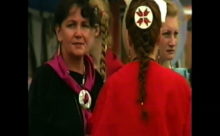Miami Indian Powwow Teaching Guide
Miami Indian Powwow, Teaching Guide
Part 3 of the Indiana Folklife series takes viewers to an intertribal powwow hosted by the Miami Indians in Columbia City, Indiana. The powwow has become one of the most recognizable forms of Native American celebration today, and occurs in virtually every state in the U.S. But despite the many similarities among these powwows, the Miami powwow is a unique event, one tied to their tribal identity as Miami as well as their intertribal identity as Native Americans. Of particular focus is how personal, social, cultural and political identities are created through regalia, religious practice, music, and dance.
BRIEF HISTORY:
The term “powwow” is derived from an Algonquian word for a healing ritual (“pauau”). The term was adopted by whites who were fascinated with such rituals and the large number of Native Americans who attended them. In time, whites liberally applied the term to any large Native American gathering. Since then, powwows have been re-appropriated by native communities.
Most tribes can trace the origin of their powwows to seasonal ceremonies where members of the community gathered together for days of feasting, music, dance, and games. The contemporary powwow, however, draws its more direct influences from the traveling Wild West shows of the nineteenth and twentieth centuries such as Buffalo Bill’s Wild West. And much of this inspiration came from Plains Indiana culture.
For Discussion:
“It’s a Miami thing. In history books I read about times where some of our leaders would go to Cedar Point, Sandusky, Ohio, and they would meet with leaders and that was considered a powwow. Old friends would get to see each other again; they would have a party.”--Dani Tippmann, Miami
“Our tribe didn’t really get involved with powwows until about 20 years ago, so we’re not really a powwow people.” --Scott Shoemaker, Miami
Q: The quotes above seem to be contradictory. Why might they be? Why not? How is each person defining “powwow”?
FUNCTIONS OF THE POWWOW
The powwow functions in many different ways for different people. Most of these functions can be divided into 5 categories: entertainment, social, cultural, spiritual and economic. When divided up like this, the powwow can be compared to a range of more familiar events.
Entertainment:
1. To have fun. Compare to any party or festival.
Social:
1. Meeting new people, making new friends. Compare to summer camp or college.
2. Homecoming: chance for extended families and friends to reunite. Compare to a family reunion.
Cultural:
1. Learning own traditions: chance to teach younger generations the traditions of one’s tribe and those of the larger Native American community. Compare to time spent with grandparents.
2. Educating the public: chance to teach non-Indians about their culture. Chance to destroy stereotypes and misconceptions. Compare to school.
Spiritual:
1. Religious event: the arbor is sacred area, like an altar in a church. Many people dance saying prayers, thanking and honoring God, often called the Creator. Compare to any church service.
2. Honor: people honor both the divine (God), and those men and women that have earned respect. The powwow especially honors veterans of the Armed Forces. There are also honor dances to honor particular individuals for their achievements. Compare to an awards ceremony or graduation.
Financial:
1. Personal: some powwows are competition powwows where dancers compete for prize money. The Miami powwow is not such a powwow, however. Even for those that are, people are not likely to get rich, though they may be able to make a living at it. Many of the vendors at powwows can more easily make a living selling their art and crafts. Compare to any job or occupation.
2. Communal: towns will often make money when visitors come and spend money in the town during an event (compare to any convention hosted by a city or (on a larger scale) the Olympics, which draws lots of outside visitors and outside money. More specifically, hosts can raise money for their community. The Miami hold an auction to raise money for a scholarship fund for young members of their tribe. Compare to any fundraiser (raffles, auctions, benefits).
IDENTITY
Native Americans throughout the country negotiate levels of identity, most particularly the tribal versus wider Native American identification. The Miami are particularly interesting in this respect, considering their unsuccessful fight to gain federal recognition as a tribe. Nonetheless, the Miami are acutely aware of their distinctly Miami identity, something they express In the many functions of the powwow.
For Discussion:
Q: What parts of the Mihsihkinaahkwa powwow are particular to the Miami? What parts have been borrowed?
Q: Who seems to be participating in the powwow? When they talk about getting together with new and old friends, who do they mean?
Q: What seems to be more important: tribal identity or identity as a Native American in general? What are the differences between the two?
Q: How do you identify yourself? What are the traditions of the communities you belong to?
